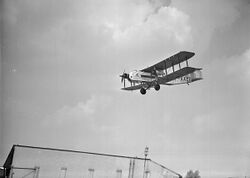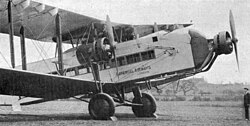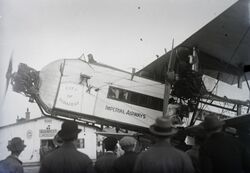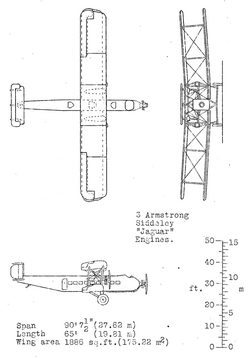Engineering:Armstrong Whitworth Argosy
| Argosy | |
|---|---|
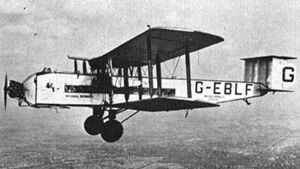
| |
| An Argosy Mk I of Imperial Airways in 1926. This particular aircraft (G-EBLF) bore the name City of Glasgow. | |
| Role | Airliner |
| Manufacturer | Armstrong Whitworth |
| First flight | 16 March 1926[1] |
| Introduction | 1926 |
| Retired | December 1936 |
| Status | Out of production, out of service |
| Primary users | Imperial Airways British Airways Ltd United Airways Ltd |
| Number built | 7 |
The Armstrong Whitworth Argosy was a three-engine biplane airliner designed and produced by the United Kingdom aircraft manufacturer Armstrong Whitworth Aircraft. It was the company's first airliner.[2]
The Argosy was developed during the early-to-mid 1920s in response to a statement by Imperial Airways that new multi-engined airliners were being sought to replace its single-engined counterparts then in use. Armstrong Whitworth proposed a relatively large biplane airliner, powered by three Armstrong Siddeley Jaguar engines; its construction largely composed of plywood and fabric supported by steel tubing. Imperial Airways opted to initially order a pair of aircraft to serve its European routes, while the Air Ministry ordered a single example as well. On 16 March 1926, the first Argosy, G-EBLF, performed its maiden flight.
Following the delivery of the second aircraft to Imperial Airways, the Argosy performed its first passenger flight on 16 July 1926, flying from London to Paris. Using the type, Imperial Airways inaugurated the world's first named air service, the luxury 'Silver Wing' service, between these two cities.[3] The type would be operated by the airline for nine years, during which time a total of three Argosies would be lost in accidents, although only one of these resulted in fatalities. During 1935, Imperial Airways opted to retire all remaining aircraft in favour of the next generation of airliners, which were larger and equipped with four engines instead.[4] All operators had withdrawn the type by the end of 1936.
Design and development
Background
The origins of the A.W.154 Argosy can be heavily attributed to the release of a specification by the British airline Imperial Airways in 1922.[2] This specification sought a new airliner to serve on its Middle East routes. Amongst the requirements listed was a range of 500 miles (800 km), even when flown into a headwind of 30 miles per hour (50 km/h), as well as stipulating the use of multiple air-cooled engines; the airline would subsequently declare a policy for all its airliners to be multi-engine on the grounds of safety.[5][2] In order to achieve this, Imperial Airways would need to procure replacement aircraft for much of its fleet, which largely consisted of aging single-engine de Havilland-built aircraft which Imperial Airways had inherited from its constituent companies, such as Daimler Airway.[6]
Although the company had no prior experience of designing airliners, Armstrong Whitworth decided that it would respond with its own proposal.[2] It was a relatively large biplane, possessing an angular box-shaped fuselage that was paired with a biplane tail featuring three fins and rudders. The aircraft was powered by three Armstrong Siddeley Jaguar engines, each capable of producing up to 385 hp (287 kW); one engine was sited at the tip of the aircraft's nose while the other two were mounted between the two wings.[7] All fuel was accommodated within two tanks at the center of the upper wing. The structure was composed of steel tubing, with most exterior surfaces being covered by fabric, including the walls and ceiling of the passenger compartment.[7] This cabin featured a wooden floor, which also acted as bracing, and amenities such as openable windows and a toilet. Baggage was housed in a main hold at the rear, a secondary baggage compartment was located in the nose just forward of the cockpit.[7]
Into production
Upon reviewing the submission, Imperial Airways decided that the proposed airliner would be suitable for its European routes, and promptly issued an initial order for two aircraft; an additional single aircraft was also ordered by the Air Ministry.[2] On 16 March 1926, the first Argosy, G-EBLF, performed its maiden flight, piloted by F. L. Barnard of Imperial Airways.[6][1] On 18 June 1926, the second aircraft, G-ELBO, made its first flight; one month later, it became the first Argosy to be delivered to Imperial Airways. The third aircraft, which had been ordered by the Air Ministry, was delivered during March 1927.[1]
During 1928, having operated their initial fleet with satisfactory results, Imperial Airways placed an order for a further three Argosies, which was later increased to four.[8] These later aircraft were designated as Argosy Mk. II and were fitted with more powerful 410 hp (310 kW) Jaguar IVA engines, an increased fuel capacity and the addition of automatic wingtip slots. The first Argosy Mk. II version was introduced to service during 1929.[9]
Operational history
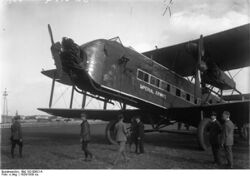
The Argosy was initially used on European routes (later operating on services to South Africa), with individual aircraft being named after cities.[1] The first passenger flight was from London to Paris on 16 July 1926. Early on, Imperial Airways were keen to demonstrate the capabilities and potential uses for their new airliner; its interior was considerably more spacious than any of its rivals upon its introduction. According to aviation author Oliver Tapper, the introduction of the Argosy led to a rapid expansion in passenger numbers being carried by the airline that started within weeks of its introduction.[11]
Imperial Airways used the Argosy to launch the world's first named air service, the luxury 'Silver Wing' service, which was operated between London and Paris.[3][12] Aircraft assigned to this service would have two of their seats removed, the space being used to accommodate an onboard bar and a steward was in attendance. During April 1931, Edward, Prince of Wales and his brother Prince George flew home from Paris–Le Bourget Airport in City of Glasgow (G-EBLF), which landed specially in Windsor Great Park.[13][14][15]
Starting in 1929, the timing having been largely due to protracted international negotiations, the Argosy was one of the aircraft used on the first air mail route of the British Empire, spanning from London to Karachi, India .[16] Following the arrival of the Argosy Mk IIs during 1929, Imperial Airways opted to have the three Mk Is reengined with the same powerplants to boost their performance. On 28 February 1931, two of these reengined Argosies were used to launch the air mail route through to Cape Town, South Africa ; this route proved to be particularly troublesome for the type with low reliability levels being achieved, and left the European routes somewhat underequipped in the process.[17]
Three Argosies were lost during service with Imperial Airways, one being written off in a forced landing near Aswan, and one during a training accident, both in 1931, with no injuries in either accident. On 28 March 1933, however, the City of Liverpool caught fire over Belgium, causing a crash in which all three crew and twelve passengers were killed.[6][18]
Argosies continued in service with Imperial Airways until 1935, with the last example, City of Manchester (G-AACJ), being used for joy-riding by United Airways Ltd of Stanley Park Aerodrome (Blackpool), which later was merged into British Airways Ltd. It continued in use with British Airways until December 1936.[19]
Variants
- Argosy Mk I :Three-engined airliner. Powered by three 385 hp (287 kW) Armstrong Siddeley Jaguar IIIA radial piston engines. Later fitted with Jaguar IVA engines. Three constructed.
- Argosy Mk II :Three-engined airliner. Powered by three 420 hp (313 kW) Armstrong Siddeley Jaguar IVA radial piston engines. Four constructed.
Operators
 United Kingdom
United Kingdom
- British Airways Ltd
- Imperial Airways
- United Airways Ltd
Imperial Airways Argosy fleet 1926–1935
| Type | Registration | Name |
|---|---|---|
| Mk. I | G-EBLF | City of Glasgow |
| Mk. I | G-EBLO | City of Birmingham |
| Mk. I | G-EBOZ | City of Wellington (later renamed City of Arundel) |
| Mk. II | G-AACH | City of Edinburgh |
| Mk. II | G-AACI | City of Liverpool |
| Mk. II | G-AACJ | City of Manchester |
| Mk. II | G-AAEJ | City of Coventry |
Specifications (Argosy II)
Data from British Civil Aircraft since 1919,[20] Armstrong Whitworth Aircraft since 1913[21]
General characteristics
- Crew: 2
- Capacity: 20 passengers
- Length: 64 ft 6 in (19.66 m)
- Wingspan: 90 ft 0 in (27.43 m)
- Height: 19 ft 0 in (5.79 m)
- Wing area: 1,890 sq ft (176 m2)
- Empty weight: 12,090 lb (5,484 kg)
- Max takeoff weight: 19,200 lb (8,709 kg)
- Powerplant: 3 × Armstrong Siddeley Jaguar IVA 14-cylinder radial engines, 420 hp (310 kW) each
Performance
- Maximum speed: 110 mph (180 km/h, 96 kn)
- Cruise speed: 90 mph (140 km/h, 78 kn)
- Range: 405 mi (652 km, 352 nmi)
- Time to altitude: 4.5 min to 3,000 ft (910 m)
See also
Related development
Aircraft of comparable role, configuration and era
- Armstrong Whitworth Atalanta
- Armstrong Whitworth Ensign
- de Havilland DH.34
- de Havilland Hercules
- de Havilland Albatross
- Vickers Vulcan
Related lists
- Civil air transport
References
Citations
- ↑ 1.0 1.1 1.2 1.3 Tapper 1988, p. 211
- ↑ 2.0 2.1 2.2 2.3 2.4 Tapper 1988, p. 209
- ↑ 3.0 3.1 Taylor 1980
- ↑ Tapper 1988, p. 219
- ↑ Jackson 1973, p. 49
- ↑ 6.0 6.1 6.2 Donald 1997, p. 63
- ↑ 7.0 7.1 7.2 Tapper 1988, p. 210
- ↑ Tapper 1988, p. 213
- ↑ Tapper 1988, pp. 213–214
- ↑ Higham, Robin (2016). "Centre pages". Britain's Imperial Air Routes, 1918 to 1939: The Story of Britain's Overseas Airlines (Revised ed.). Fonthill. ISBN 978-1-78155-370-1. https://books.google.com/books?id=SQfzDQAAQBAJ&dq=Jack+Sanderson+steward&pg=PA1922.
- ↑ Tapper 1988, pp. 211–212
- ↑ Tapper 1988, p. 212
- ↑ "Arrival at Windsor by Air". The Straits Times. 30 April 1931. http://newspapers.nl.sg/Digitised/Article/straitstimes19310430-1.2.53.aspx.
- ↑ "Princes Home". The Advertiser and Register. 1 May 1931. http://nla.gov.au/nla.news-article45763837.
- ↑ Tapper 1988, p. 217
- ↑ Tapper 1988, p. 215
- ↑ Tapper 1988, pp. 215–217
- ↑ Tapper 1988, pp. 217–218
- ↑ Tapper 1988, p. 218
- ↑ Jackson 1973, p. 49-51
- ↑ Tapper 1988, pp. 253–254
Bibliography
- Donald, David, ed (1997). The Encyclopedia of World Aircraft. Aerospace Publishing. ISBN 1-85605-375-X.
- Jackson, A.J (1973). British Civil Aircraft since 1919 Volume 1 (2nd ed.). Putnam & Co. ISBN 0-370-10006-9.
- Mondey, David, ed (1978). The Complete Illustrated Encyclopedia of the World's Aircraft: Military and Civil Aviation From the Beginnings to the Present Day. Secaucus, NJ: Chartwell Books Inc. ISBN 0-89009-771-2. https://archive.org/details/completeillustra00mond.
- Tapper, Oliver (1988). Armstrong Whitworth Aircraft since 1913. London: Putnam. ISBN 0-85177-826-7.
- Taylor, M J H, ed (1980). Jane's Encyclopedia of Aircraft. Jane's Publishing Company.
External links
- Newsreel footage of Armstrong Whitworth Argosy in flight
- Armstrong Whitworth Argosy Mk. I illustration in May 1927 Popular Mechanics article
 |
